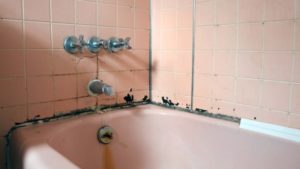8 Dangerous Home Problems You Can Uncover Before You Buy

The home inspection is that pivotal event you hold your breath for when you’re buying a house. It’s an opportunity for a licensed expert to scrutinize every inch of your potential new place for problems—both minor ones and the deal-killing kind.
But when so much is on the line, why wait until the inspection to start investigating? Open houses and private showings are the perfect time to get a little nosy. Let us be clear: We’re certainly not suggesting you should forgo the expertise of a home inspector. But you can get a jump-start so that you can turn your inspector’s attention to some potential problem areas.
These eight crucial problems can be easily uncovered—even without a home inspector’s license. So go ahead and take a peek.
Source
1. Cracking caulking
Get on your knees and examine the caulking around the sinks and tubs. While cracking could just be a sign of age, it also might indicate mold inside the wall (a no-go, unless you’re up for a major challenge).
“Any cracks or holes must be taken care of before you go further,” says Bill Horne, a former landlord and commercial real estate owner. Keep an eye out for dark stains, too, which also might indicate something nasty growing underneath.
2. Insulated recessed lighting
You may not get a chance to peek in the attic during a showing, but do your best to scamper up there. Access to the attic means you can check on insulation issues, storage space, and safety problems—like poorly installed recessed lighting.
Once you’re up there, find out where the recessed lights are installed. Is there insulation resting on the cans?
3. Insulation with foil side up
While you’re poking around the attic, take a peek between your feet. If the home’s insulation has been installed between the joists, you’d better not see your reflection.
“If the insulation’s foil side is up, it will probably have been ruined by moisture coming up. Also called the “vapor barrier,” the foil-lined side should face the warm side of the house—i.e., your main rooms—not the cold attic.
4. Slouching walls
Crooked or leaning walls, or floors that aren’t level, can indicate serious foundation issues.
No need to bring a level to every open house. A careful eye is good enough (until the inspection, that is). And here are a couple of fun hacks: Set a coin on its edge. If it rolls, you’ve got a crooked floor. Or press your cheek against the wall and look for any strange slopes or irregularities.
You don’t need to dismiss a home simply because it’s a bit crooked. Remember: Old structures settle in curious ways. But if what you see seems peculiar, make sure to add it to the must-inspect list.
5. Rusty basement columns
If you get to poke around an unfinished basement, Horne recommends examining the lally columns—the skinny steel tubes that hold up the main beams.
Look for peeling or rust, which “is a sign that there might be dampness in the cellar,” he says. Even if moisture tests don’t indicate a problem, rust could compromise the support that column offers.
6. Multiple pipe styles
A mingling of multiple pipe styles doesn’t necessarily mean something nefarious is afoot. Perhaps the homeowner was replacing the system piecemeal and ran out of cash (hence the sale?). But if you see a mix of several styles—maybe some are cast iron and some PVC—you’ll want to alert your inspector to find out why. Frozen water pipes might have forced a partial replacement.
Poor winterization, and the resulting burst pipes, don’t necessarily mean anything is bad.
But it’s a danger sign, because it means that there was a lot of water in the cellar at some point
7. Slow drainage
During a walk-through, make sure to let the water flow—everywhere the Realtor® will let you, at least. Turn on the faucets for every sink, toilet, or tub, and watch carefully as the water drains.
“Slow drainage indicates clogged drains or substandard installation,” Horne says. It gets worse: You could even have a sewer line disaster waiting to happen—and that’s an expensive fix.
8. Too few vent pipes
While you’re checking out the backyard, take a peek at the roof and count the vent pipes. One vent pipe should line up with the kitchen, and there should be an additional vent pipe for each bathroom.
Like most issues, a shortage of vents doesn’t make the home uninhabitable. Sure, if the bathrooms aren’t vented, it might mean an additional expense down the line, but it’s not the end of the world.
But don’t assume you’re in the clear, even if the kitchen and all bathrooms are vented. If the vent ends in the attic, it could send dangerous amounts of moisture into your home.
Buying or Selling? Send Linda a Message
Contact Linda
Swanson Real Estate
503 E. Church St.
Sandwich, IL 60548
815.742.8161 Direct
815.786.9418 Office
Search Listings
Areas Served: Big Rock, Hinckley, Marseilles, Naperville, Newark, Oswego, Plano, Sandwich, Sheridan, Somonauk , Sugar Grove, Yorkville
